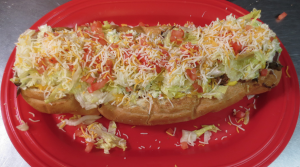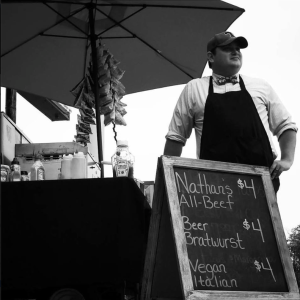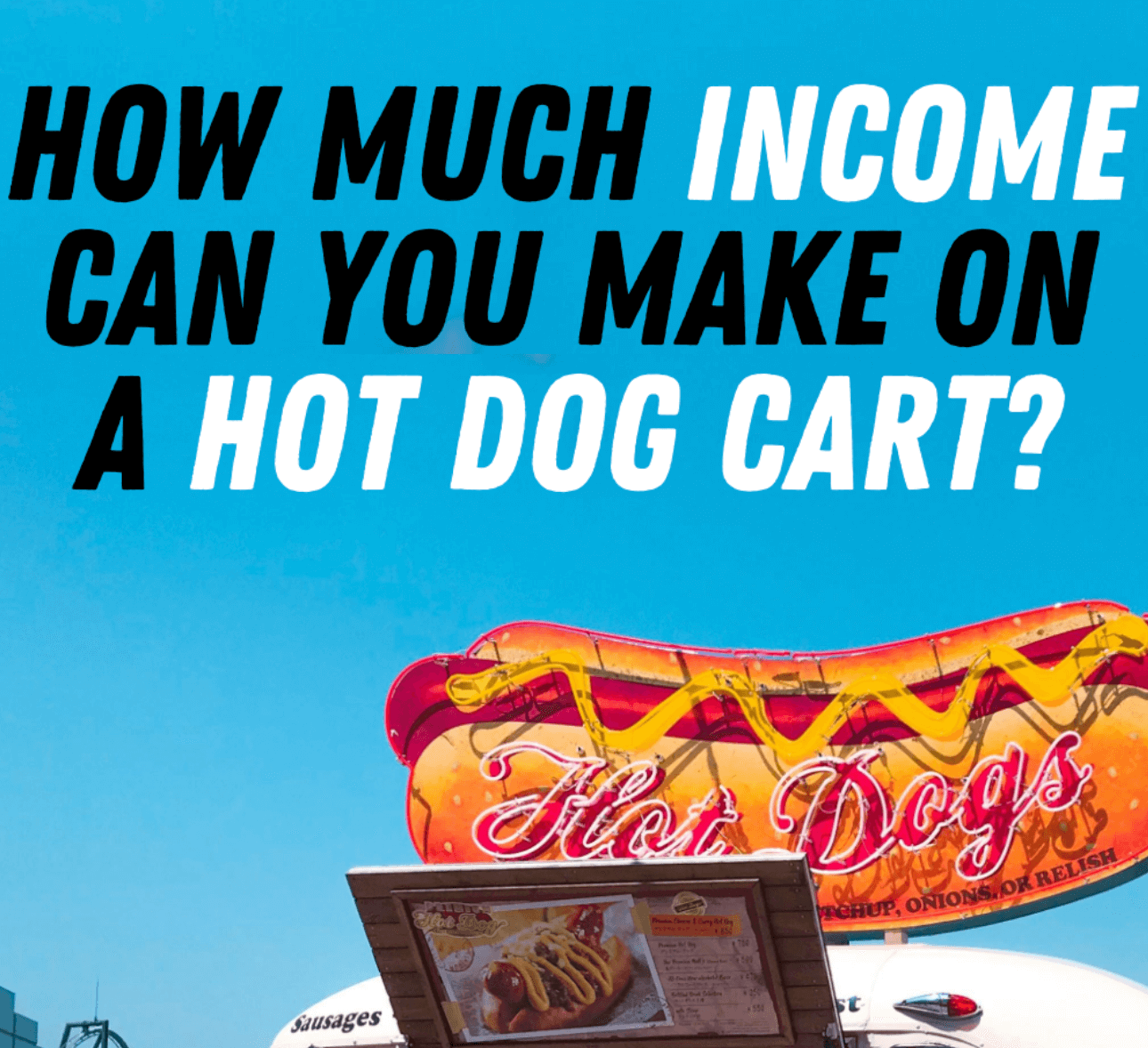How much income can you expect to make on a hot dog cart? In today’s podcast episode we get to the bottom of the “how much can a hot dog cart make?” question with Matt Gladfelter of Bow Ties and Hot Dogs in Knoxville, Tenn. Matt has been operating his business for more than 5 years. Matt understands the different between hype and reality with income numbers and how much work actually goes into hitting certain sales thresholds.
We begin our conversation with low-ball sales estimates. According to Gladfelter if you aren’t able to go out and generate at least $100 in sales within 2 – 3 hours you’ve got the worst location in the world or something is wrong with your presentation or image and you’re turning people away. You need to either move on to a better location or reevaluate your presentation if y0u find yourself in this situation.
But on average on a hot dog cart? Gladfelter explains that he usually shoots for $300 – $500 in sales per day on weekdays. On the weekends you’re looking for the higher value local events with the goal of doing $500 – $1,000 in daily sales. A good goal when starting out is finding locations where you can get 100 sales per day consistently.
Here’s how the math work on some different hypotheticals:
- 50 customers per day * $8 per dog = $400 per day
- 100 customers per day * $8 per dog = $800 per day
- 150 customers per day * $8 per dog = $1,200 per day
Here’s another example if you’re selling a meal with hot dog, chips, soda or other premium beverage as a combo deal:
- 50 customers per day * $10 per meal = $500 per day
- 100 customers per day * $10 per meal = $1,000 per day
- 150 customers per day * $10 per meal = $1,500 per day
Gladfelter explains that before getting into the hot dog business, you need to determine how much you need to make on a monthly basis to make the business worthwhile to operate. If you are looking for a side-hustle that brings in an extra $1,000 – $2,000 per month, you won’t need to work as hard as someone who needs $10,000 per month to cover their expenses.
Now that you understand the average income you can expect on a hot dog cart. Let’s dive into specific ways you can increase profits with a hot dog cart below:
Create Higher Value Offerings
You’ll need to sell 100 hot dogs at $4 a piece to reach $400 per day in sales. But, if you’re able to move the average sale price to $6 – $10 you’ll need a lot less customers over the course of a shift to be profitable. One way to increase your average customer value is to offer value meals or boxes where you bundle menu items and drinks together.
For example, if you sell at hot dog at $4 a piece you could offer a drink and a side of coleslaw for a total of $6. Fast food restaurant chains are famous for doing the same thing in their industry and has help these businesses attain longterm profitability. There’s a reason McDonald’s asks if you would like fries and a drink with that for only $2 more. They are increasing the average income per customer by doing so.
There are a variety of menu items that Gladfelter has used to offer additional products beyond that hot dog. These items include giant pickles, baked beans, corn on the cob, and an assortment of different drinks like fresh squeezed lemonade.
You can also test serving higher value condiments like bacon wrapped hot dogs, small batch ketchup, organic sauerkraut or premium mustards from small producers. You can often charge an extra $1.00 – $2.00 by adding premium items like this to a hot dog. This bumps up your average ticket price and helps you make more money with each transaction on average.
Frequency of Serving
In the hot dog game, it’s all about hitting the streets regularly. More days out there, more dough in your pocket. Here’s why frequency and consistency are your best pals in this business:
You can’t plan your life on maybes. Being out there more means you can count on a certain amount coming in. This is key for paying bills and keeping the lights on.
Now, let’s talk numbers. Suppose you’re making between $400 to $1000 each day you’re out using the 100 customer per day rule:
- 5 Days a Month: You’re probably lookin’ at about $1,000 to $3,000 a month. It’s not bad money for a side-hustle, but it doesn’t bring in enough income after expenses to pay most people’s bills either if you want to go full-time. Some months might be lean if the weather’s bad or if there’s some other reason folks ain’t buying.
- Annual Income (Estimate): $12,000 – $36,000
- 20 Days a Month: Now you’re cookin’. You’re looking at $5,000 to $13,000 a month at this level. That’s a serious step up. More regular, more predictable. You’re a known face, and people count on you for their lunch.
- Annual Income (Estimate): $60,000 – $156,000
- 25 Days a Month: This is the big leagues. You’re potentially pulling in $8,000 to $20,000. That’s some serious cheddar. But remember, this is hard work and long hours. You gotta be sure you can handle the grind.
- Annual Income (Estimate): $96,000 – $240,000
Bottom line: The more you’re out there, the more you make. If you go on vacation, your income goes to zero for that day. It’s a grind, but that’s the game. More days on the street means more chances to sell, and that’s what fills your pockets at the end of the day. Overtime, you’ll be able to keep track of the locations that are your top producers. Keep going to locations that make money and drop locations that don’t pay well over time.
Gross Income Versus Net Income
Gross versus net income is a key concept to remember when operating a hot dog business when hearing about income potential. When someone sales, I made $500 operating a hot dog cart today, they are usually referring to their gross sales numbers. This is the amount of income the business generated BEFORE product costs and taxes.
You can think of this like a when you get a regular paycheck from your employer. You might get paid $20 an hour (this is your gross income), but after state and federal taxes you may only see about $15 an hour in your wallet (this is net income).

Taco dog with Mexican cheese, lettuce, and tomato.
When operating a hot dog business, here are the costs you can expect:
- Cost of Goods Sold (COGS) – This should be at around 1/3 of your gross income. This includes hot dog buns, propane to fill your tank, napkins, and other products you sell. Don’t forget about the price for condiments like relish, grilled onions, sauerkraut, ketchup, mustard, chips, foil, paper plates, soda, lemonade and anything else you decide to offer on the cart.
- Operation Costs – If you’re just starting out, I’ll assume you do not have any employee expenses and plan to operate the cart yourself in the early days. If you plan to hire an employee to run the hot dog cart, you’ll have more overhead in the form of labor. Also keep in mind the cost of gas to travel to different locations, insurance, fees from payment processors or credit card, or replacing cooking equipment will be standard costs of operating the business. Learn more about the startup and operational costs of a hot dog business here.
- Taxes – Just like any other business you are responsible for paying taxes.
- Net Income – This is what you get to keep after the all your expenses, including taxes, are paid.
Add a Tip Jar
Alright, so here’s the deal with a tip jar on a hot dog cart. It’s like this secret weapon for boosting your cash flow, without much extra work. As any waiter or bar tender will tell you as well, you can make pretty decent extra money just from a few tips per day.
Gladfelter says you can generate an extra $20 – $50 per shift pretty easily by placing a tip jar on the cart. Now, for the tricks of the trade to bump up those tips:
- Crack a Joke or Two: Everyone loves a laugh. If you’ve got a few good jokes up your sleeve, share ’em. Make ’em laugh, and they’ll remember you. Happy customers are more likely to throw a tip your way.Example: “Why don’t hot dogs star in movies? Because they always get roasted!”
- Signs That Encourage Tips: Sometimes folks just need a little nudge. A clever or funny sign can do wonders. Something like, “Help support my hot dog habit,” or “Fear change? Leave it here!” It’s a light-hearted way to remind people that tips are welcome.
- Be Grateful: Always say thanks when someone tips. A bit of gratitude goes a long way. It shows you don’t take their generosity for granted.
- Create a Tip Goal: Sometimes I put up a sign with a goal, like “Help me buy a new umbrella for the cart!” People like to know their tips are going for something specific and helpful.
- Keep It Clean and Tidy: A clean and well-organized cart can make a good impression. People might be more inclined to tip if they see you take pride in your setup.
Remember, the tip jar ain’t a miracle worker, but it sure can help boost your take-home pay. Be friendly, be yourself, and let the customers see the hard-working person behind the cart. That’s how you get them tips rolling in.
Regional Income Factors
Where you live and operate can increase the potential earnings on a hot dog cart significantly. Live in a warm climate like California or Arizona? In the southern United States you may be able to operate as frequently as you want year round. The more times you’re able to go out and operate over the course of a year, the more money you can make.
If you happen to live in Minnesota where the winters are too cold to get outside and vend you will have fewer opportunities to go out and make money. One the other hand if you plan to operate outside the Central Park Zoo in New York City, you’ll need to invest a reported $289,500 to legally vend. Fortunately, this is the exception and not the rule for slinging hot dogs.

Live in a higher cost city? You can increases your overall profits simply by raising prices. Gladfelter operates his hot dog carts in Tennessee and typically charges $4 for a Nathan’s Quarter Pound All-Beef Hot Dog. If you happened to live in a coastal or tourist type community, you may be able to charge $6 – $10 for the same product. By understanding these regional factors, you can more accurately estimate the profitability of your cart and charge what you’re worth.
Quotes From The Show
You’re going to get a lot of varied answers from different vendors. And I hate to say this but motivation has a lot to do with those answers. – Matt Gladfelter on estimating a food carts income.
Your goal is 50 – 100 people (customers) per day. So your location is obviously going to dictate that completely. – Matt Gladfelter on the importance of identifying profitable vending locations.
Not a lot of cars are going to stop for a hot dog cart, unless they know who you are. – Matt Gladfelter on the importance of building a brand.
To me I’ve found that events are where it’s at because literally in 5 hours you can make thousands of dollars. And that’s not smoke and mirrors. – Matt Gladfelter on the types of locations that drive the most revenue.
It’s a process. Gradually you want to move out and replace your slowest locations. – Gladfelter on the process of identifying better and more profitable vending locations over time.
Mentioned in the Show
O’Doggy’s – This is a hot dog cart that has grown into a restaurant located in Rolla, Missouri. Gladfelter cites O’Doggy’s as an inspiration as to how many creative types of hot dogs can be developed.
Hot Dog Business Market Research – Like this interview? You’re going to love our previous conversation with Gladfelter about how to conduct market research and write a business plan for a hot dog cart.



